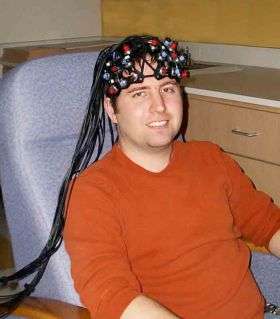Brain images show schizophrenic's memory usage differs

T he enduring memory problems that people with schizophrenia experience may be related to differences in how their brains process information, new research has found. The Public Library of Science published the report by Vanderbilt University researchers Junghee Lee, Bradley S. Folley, John Gore and Sohee Park in the online journal PLOS One on March 12.
"We found that schizophrenic patients use different areas of their brain than healthy individuals do for working memory, which is an active form of short-term memory," Park says. "Both groups used their frontal cortex while remembering and forgetting. However, while healthy subjects groups used the right side of this brain area when asked to remember spatial locations, the schizophrenic patients used a wider network in both hemispheres.
"This suggests that while healthy people recruit a specialized and focused network of brain areas for specific memory functions, schizophrenic patients seem to rely on a more diffuse and wider network to achieve the same goal."
The researchers also found a fundamental difference in the way healthy people and schizophrenic patients made errors. When healthy people forgot, they had no confidence in their response for that trial and the brain areas that were recruited during correct memory trials remained inactive. A more complex picture emerged for schizophrenic patients.
"When healthy people are correct, there is an increased activation of the right frontal cortex. When they forget, there is no such increase. Their brain activation pattern is tightly coupled with their memory performance. Not so with schizophrenic patients," Park says.
"Schizophrenic patients may encode and remember incorrect information. The brain activation pattern during such error trials indicate that indeed they were remembering something, albeit incorrect," she continues. "Such coupling of storing incorrect information and feeling confident of one's response may be one way to think about how delusions get initiated," Park says.
Researchers have known since the early 1990s that working memory problems are a consistent symptom of schizophrenia. The researchers sought to better understand what is occurring in the brain that may be causing these problems.
"The right hemisphere is usually recruited during spatial information processing but if it is malfunctioning, as it may be in schizophrenia, the left hemisphere may also be recruited," Park says. "Another possible explanation is that schizophrenic patients may have more difficulty with these tasks, and as a result recruit more brain areas to assist them."
In the experiment, the subjects were shown a point on a computer screen and told to concentrate upon it. Three identical black circles were then flashed on a gray background, each in a different location. After a short delay, the subjects were shown a probe and told to press one key if the probe matched one of the circles shown earlier and another if it did not. They then were told to press another key ranking on a scale from one to five their confidence in their answer about the probe.
The researchers captured images of brain activity during these tasks using functional magnetic resonance imaging, or fMRI. They repeated the experiment to capture data using another tool, near infrared spectroscopy, or NIRS. NIRS is a new and promising way to study schizophrenia, the researchers believe.
"Many patients exceed the fMRI safety weight limit due to the side effects of their medication. The paranoia and anxiety that are often part of this disorder also make fMRI, which involves entering a tube while laying down, impossible for many patients. Also, individuals with metal implants cannot be scanned," Park says. "NIRS does not have these problems. As a participant, you sit in an office chair while the experimenter places a plastic 'probe set' on your head with a couple of straps. Even babies tolerate it pretty well. Our study demonstrates that NIRS can be used as a viable alternative to fMRI, which means many more people can participate in experiments."
The researchers chose to publish their work in PLOS One, a relatively new, open access journal, because it is freely available to the public.
"We felt that the fact that anybody can access scientific papers in this journal was a big plus," Park says. "One normally has to pay for access to journals. Most schizophrenic patients, including the individuals who participated in our study, simply do not have the money to do so. This article is available for free to anyone."
Source: Vanderbilt University





















